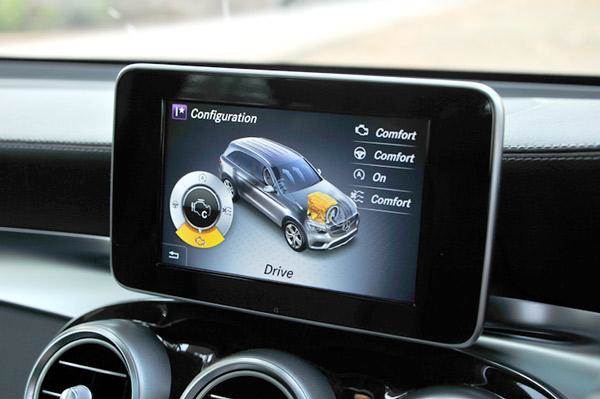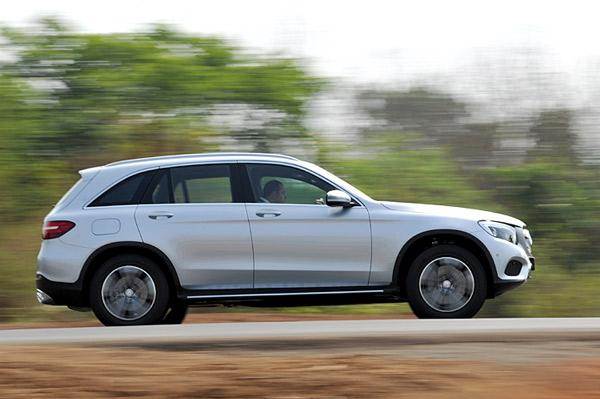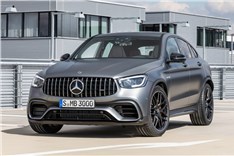Mercedes GLC India review, test drive
Mercedes finally plugs the only serious gap in its model range with the new GLC; an SUV that promises to the spoil Audi Q5 and the BMW X3’s party.
Published on May 25, 2016 08:30:00 AM
2,54,393 Views
Follow us on



What’s it like to drive?
In the not-too-distant past, a ‘300’ badge would have suggested a 3.0-litre engine, but this motor is a 2.0-litre, four-cylinder turbo-petrol unit pushing out a V6-like 245hp and 370Nm of torque, which seems more than adequate for a 1,871kg car, especially since it’s mated to Mercedes’ latest gearbox. In place of the old 7G-Tronic is a nine-speed torque-converter automatic with the extra ratios here for better overall performance and economy.
The gearbox does its job beautifully. In ‘Comfort’ mode, it behaves like the quintessential Mercedes unit. It is smooth and jerk-free and the fact that it has nine speeds means there are smaller gaps between ratios and this helps make the transition between gears fairly seamless. That’s not the case when you toggle the Drive selector into the most aggressive Sport+ mode where there’s a distinct thud between shifts when you accelerate hard. The GLC 300 comes with five different driving modes – Comfort, Eco, Sport, Sport+ and Individual – which alter the steering, throttle and transmission parameters. The suspension, however, which sits on steel springs, cannot be altered.

The GLC’s petrol motor has a pretty wide powerband and delivers its grunt quite progressively. There isn’t much turbo lag, but from low revs, there’s not much oomph either and instead, just a nice, gradual build-up of power with the engine really getting into its stride after 3,500rpm. Keep the pedal pinned and you can feel the GLC accelerate hard in a linear and progressive way, with no let up till the 6,500rpm redline. In fact, the action is concentrated between 4,000 and 6,500rpm which tempts us to constantly use Sport and Sport+ which gamely hang onto each gear until the redline. Downshifting from high revs via the paddles provides a great degree of control and on a twisty road, you really feel like you’re driving a manual.
The GLC 300 despatches 100kph in a brisk 7.5 seconds, which makes it faster than its four-cylinder diesel rivals. However, in the real world, especially when you want to make a quick and easy overtaking manoeuvre, you miss the kick of a strong turbo-diesel, which the GLC, with a relatively weak mid-range, certainly lacks. Part-throttle response is pretty good, though, which makes the GLC 300 easy to drive and live with.
What’s also impressive is how hushed the cabin is. Yes, this is the petrol version and the roads are reasonably smooth, but it feels eerily quiet for an SUV doing 80kph. Sounds from the suspension are successfully muffled and even wind around the A-pillar and mirrors is a gentle rustle. Noise levels rise gently when I accelerate hard and the four-cylinder engine gets quite buzzy near the redline. But it’s not to the point of feeling harsh or thrashy, which is why you don’t mind exploiting this motor’s strong top end.
The GLC also comes in a diesel variant; the base GLC220d which puts out a modest 170bhp. It may seem insufficient to propel a car weighing nearly two tonnes but thanks to nine gear ratios making full use of the decent 400Nm of torque, the diesel GLC doesn’t feel underpowered. It’s responsive of the mark and the stronger mid-range compared to the petrol makes it a better car for highway cruising. It’s remarkably refined too at moderate revs and the superb cabin insulation filters out the engine noise really well. However, when you rev the engine beyond 3,000rpm the characteristic diesel drone get quite loud. Also, this engine doesn’t like being revved too hard and feels a bit labored at the top end. Performance isn’t quite scintillating and the way the turbo spools up is more like a strong nudge than a solid kick.

The GLC drives like a jacked-up C-class and strikes a good balance between ride and handling. The pliant suspension and relatively tall 60-profile tyres smoothen out sharp edges remarkably well. In fact, the supple and refined nature of the suspension makes the GLC the most comfortable SUV in its class. At high speeds on undulating surfaces, the softly sprung GLC does move around a fair bit – it tends to pitch quite a lot at the rear and there’s even a side-to-side rocking motion when the road is really uneven. The ride may not be as flat or controlled as in the C-class sedan but it’s not to the point of truly unsettling the passengers.
The GLC’s steering really stands out for its very progressive and linear feel reminiscent of the old hydraulically powered units. Mercedes has got the on-centre feel spot on; there’s no dead zone around the straight ahead position and neither is it too quick off centre to make the GLC nervous at speed. It’s not particularly quick or very direct but for relaxed yet fast driving, it instills a lot of confidence, especially at high speeds.
Push the GLC with verve and you can tell it isn’t the sportiest SUV around. Yes, it is well balanced in corners and feels pretty stable even over mid-corner bumps, but it doesn’t feel agile and enthusiastic for rapid direction changes and there’s a fair bit of body roll. Though the four-wheel drive is meant to be set up for a rear bias, it’s obviously set up to understeer, with the front wheels breaking traction under hard acceleration out of corners (with traction control switched off, of course). It doesn’t have the rear-wheel-drive balance of an X3 and doesn’t feel as playful either.
Copyright (c) Autocar India. All rights reserved.





.jpg&w=234&h=156&q=90&c=1)





Comments
Member Login
Personal Details
No comments yet. Be the first to comment.